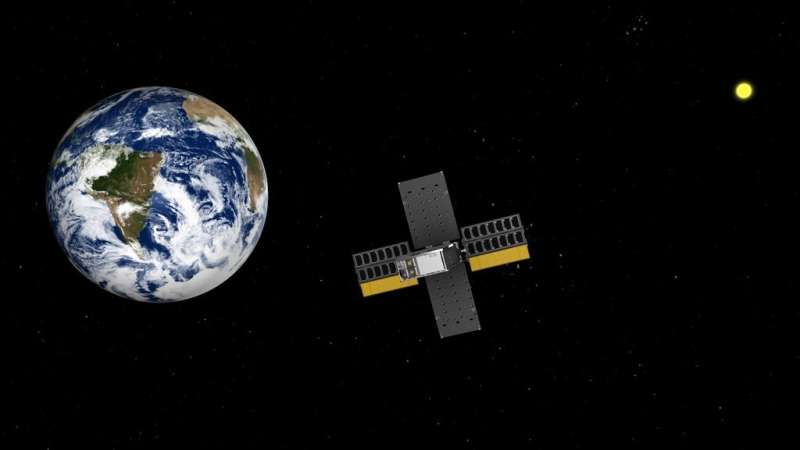This article has been reviewed according to Science X's editorial process and policies. Editors have highlighted the following attributes while ensuring the content's credibility:
fact-checked
trusted source
proofread
NASA's Lunar Flashlight to fly by Earth

NASA's Lunar Flashlight mission to the moon has ended, but the briefcase-size spacecraft will soon fly past Earth before heading into deep space. On Tuesday, May 16, at 9:44 p.m. PDT (Wednesday, May 17, at 12:44 a.m. EDT), the CubeSat will pass about 40,000 miles (65,000 kilometers) from our planet's surface.
NASA's Eyes on the Solar System
3D visualization tool will track the tiny
"As Lunar Flashlight zooms by, it may reflect enough sunlight from its solar panels that it could be seen through a modest telescope," said Barbara Cohen, Lunar Flashlight principal investigator at NASA's Goddard Space Flight Center in Greenbelt, Maryland. "Depending on its orientation and position it could be up to a magnitude 5 or 6 moving dot."
While still tens of thousands of miles away, the sunlight bouncing off the CubeSat's solar panels may be visible for those with clear, dark skies. The brightness of an astronomical object can be measured as apparent magnitude. As an object of magnitude 5 or 6, the CubeSat may be visible to backyard telescopes when it passes at its closest point over the east coast of Brazil. Observers should use NASA Horizons to check where in the sky Lunar Flashlight will be.
After launch on Dec. 11, Lunar Flashlight was sent on a long, looping path, far beyond Earth orbit. Now it has returned to the proximity of our planet, after being pulled back by the combined gravity of Earth and the moon.
The spacecraft was designed to test new technologies and address knowledge gaps by exploring permanently shadowed craters on the moon's South Pole. But soon after Lunar Flashlight launched, its operations team discovered that the CubeSat's four thrusters were underperforming. After months of troubleshooting to remedy the situation, time ran out for the spacecraft to make critical maneuvers that would have put it in orbit around Earth with monthly flybys of the moon's South Pole.
When it became clear that Lunar Flashlight couldn't get into the required orbit for lunar observations, NASA called an end to the rest of its mission. The spacecraft's other systems are functioning well and it remains in contact with mission operators. NASA is now weighing options for Lunar Flashlight's future.
After passing Earth, the CubeSat will continue into an orbit around the sun. Lunar Flashlight's orbit will bring it close to Earth once more in November 2037.
Provided by JPL/NASA




















